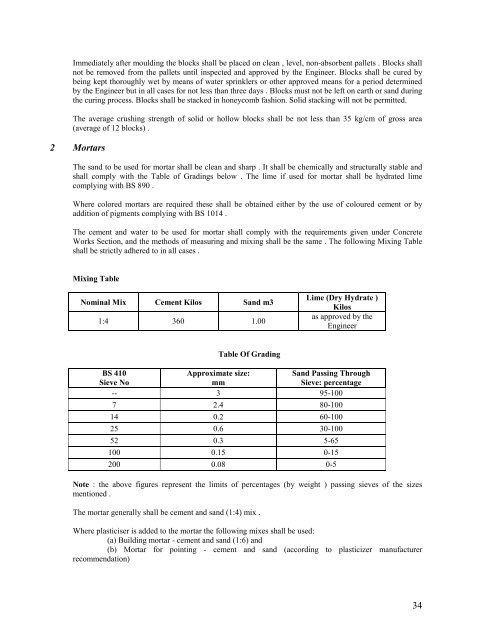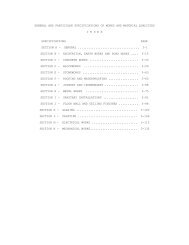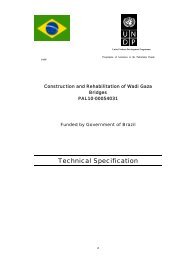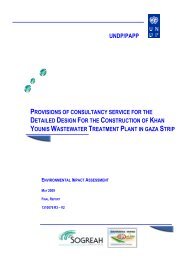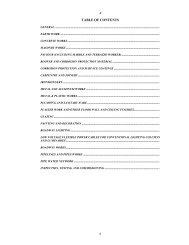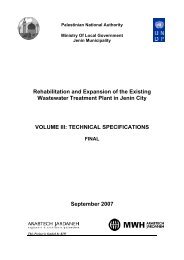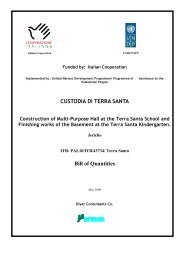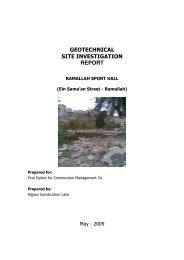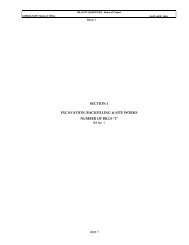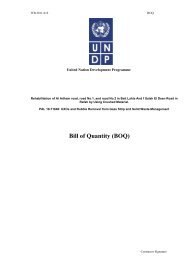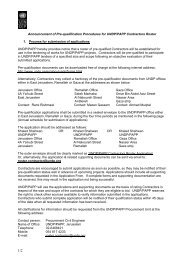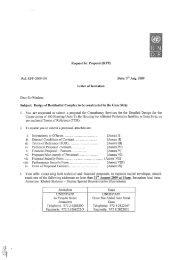Technical Specifications - UNDP
Technical Specifications - UNDP
Technical Specifications - UNDP
You also want an ePaper? Increase the reach of your titles
YUMPU automatically turns print PDFs into web optimized ePapers that Google loves.
Immediately after moulding the blocks shall be placed on clean , level, non-absorbent pallets . Blocks shall<br />
not be removed from the pallets until inspected and approved by the Engineer. Blocks shall be cured by<br />
being kept thoroughly wet by means of water sprinklers or other approved means for a period determined<br />
by the Engineer but in all cases for not less than three days . Blocks must not be left on earth or sand during<br />
the curing process. Blocks shall be stacked in honeycomb fashion. Solid stacking will not be permitted.<br />
The average crushing strength of solid or hollow blocks shall be not less than 35 kg/cm of gross area<br />
(average of 12 blocks) .<br />
2 Mortars<br />
The sand to be used for mortar shall be clean and sharp . It shall be chemically and structurally stable and<br />
shall comply with the Table of Gradings below . The lime if used for mortar shall be hydrated lime<br />
complying with BS 890 .<br />
Where colored mortars are required these shall be obtained either by the use of coloured cement or by<br />
addition of pigments complying with BS 1014 .<br />
The cement and water to be used for mortar shall comply with the requirements given under Concrete<br />
Works Section, and the methods of measuring and mixing shall be the same . The following Mixing Table<br />
shall be strictly adhered to in all cases .<br />
Mixing Table<br />
Nominal Mix Cement Kilos Sand m3<br />
1:4 360 1.00<br />
Lime (Dry Hydrate )<br />
Kilos<br />
as approved by the<br />
Engineer<br />
Table Of Grading<br />
BS 410<br />
Approximate size:<br />
Sand Passing Through<br />
Sieve No<br />
mm<br />
Sieve: percentage<br />
-- 3 95-100<br />
7 2.4 80-100<br />
14 0.2 60-100<br />
25 0.6 30-100<br />
52 0.3 5-65<br />
100 0.15 0-15<br />
200 0.08 0-5<br />
Note : the above figures represent the limits of percentages (by weight ) passing sieves of the sizes<br />
mentioned .<br />
The mortar generally shall be cement and sand (1:4) mix .<br />
Where plasticiser is added to the mortar the following mixes shall be used:<br />
(a) Building mortar - cement and sand (1:6) and<br />
(b) Mortar for pointing - cement and sand (according to plasticizer manufacturer<br />
recommendation)<br />
34


